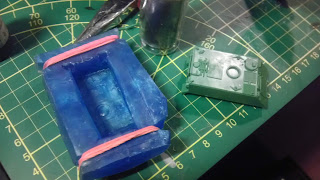At last I found a way to store at least my 15mm models properly. Some days ago I was at a local discouter and found these boxes. I took the opportunity to get some of them for my minis, these things cost 1,99 € what is ok, and, what is important, in these boxes the models should be protected from (my eternal enemy) dust.
From a friend, who is musician, I got some accustic foam, he did not need this stuff anymore but I can use it for the bottom of the boxes to secure the models as you can see on the pictures above.
There was enough for the (first?) 10 boxes, if I would need some more of this stuff I could get it from him.
Each army got its own box plus two boxes for all planes and helis, on the picture above you can see my cold war US tanks (and a batch of Heinlein books), but since I ordered another dozen of Zvezda "Art Of Tactic" expansions (the whole range will get a closer look in the future), I may need additional boxes, some of them are already full.
At the moment the helis are stored
sub-optimal, I wanted to glue some coins or stuff like this to the cover
of the box, to attach the magnetized rotors on them, but most of the
glues I already tested did not stick. And I should get a separate box for all heli and plane bases.
But
all in all I am happy with this solution, and while I sorted my models
to the new boxes, I noticed that I have a lot 15mm models, more than we
will ever use for games, but I like these small things, and I will add
more 1:100 models to my collection.
While I had a flue last week, I was not in the mood for any modelling or blogging, but last Thursday I was fit enough for another roguish Montagsmaler meeting. My mate Olli finished his Tiger 2 and started to paint another tank, while I painted several tank crews and some of the kits which I still want to review, luckily I made all pictures which are needed for this before I started to build them.
This weekend is dedicated to modelling. At the moment I have one half of Ollis 15mm Bundeswehr platoon on my bench, these kitten got an additonal layer of matte varnish and he left them here to dry. The new Vallejo matte varnish I use is great, works fine with the airbrush and the paintbrush
Just a random Montagsmaler picture:
At the moment I am planning what I will post the next days, I think it will be the Zvezda Sd.Kfz. 186, Ollis Bundeswehr models, both Italian expansions for "TANKS", and some ww2 pictures. I still have 4 "TANKS The Modern Age" expansions laying on my desk which I want to (mini)review, but one thing at a time.
Too bad, I already built one of them without taking pictures of the sprues. But I will improvise when it is time for the closer look at that kit. Not to forget to mention all the new custom unit cards I made in the past few days.
I just came home from work but now it is weekend and you can expect another post tonight, then I will take a closer look at the Sd.Kfz. 186 for Zvezdas "Art Of Tactic" wargame, I only need to take a picture of the finished kit and write some lines, the rest of the post is almost finished.











































































